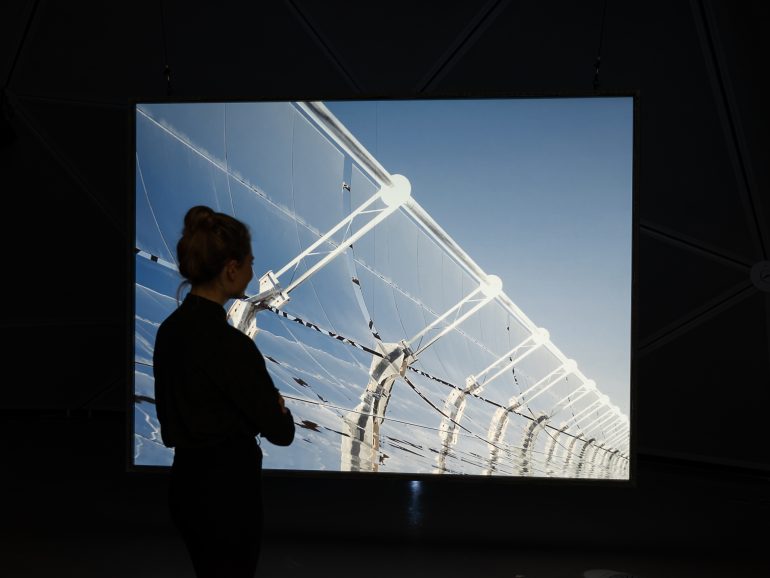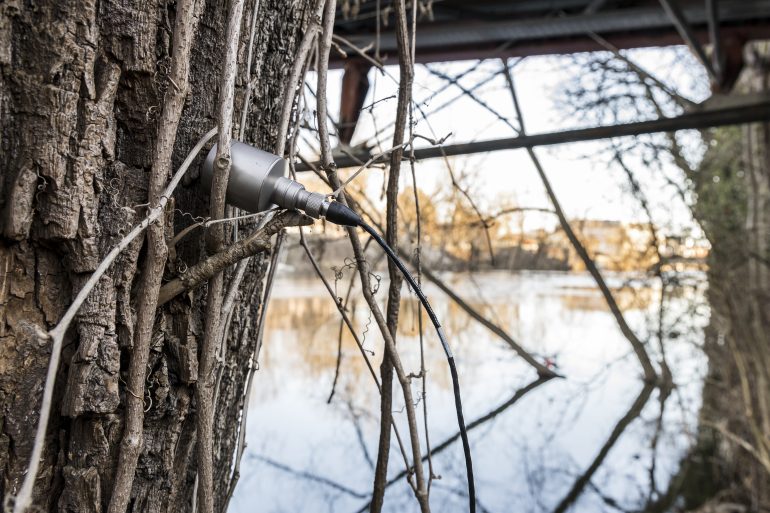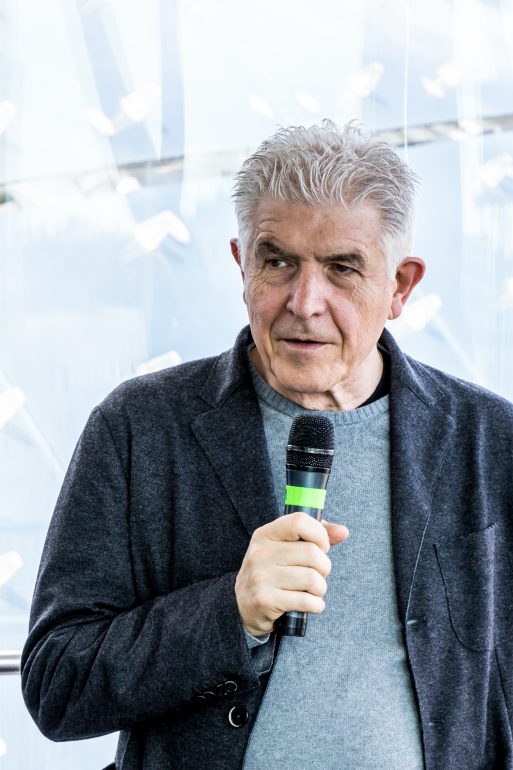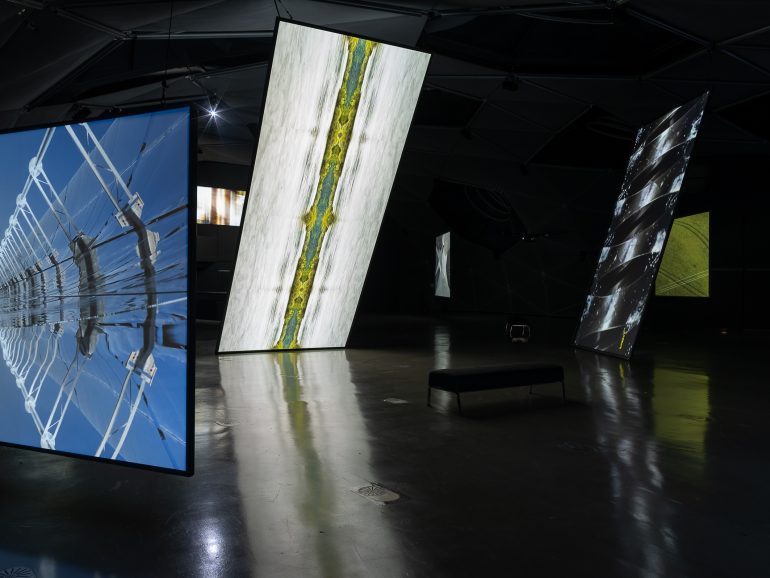
“Bill Fontana. Primal Energies”, Foto: Universalmuseum Joanneum/N. Lackner
24. März 2020 / Katrin Bucher Trantow
Interesting times …
Tausende Menschen hatten jeweils rund um den Globus daran teilgenommen. Kaum etwas hat sich seit den Anfängen der Demonstrationen im Frühjahr 2019 verändert. Manche Demonstrantinnen und Demonstranten selbst sind ohne schlechtes Gewissen rund um den Globus zum Surfen oder zum Tauchen geflogen, um sich vor dem Kollaps nur noch einmal die Schönheit der Welt anzusehen …, wie es im mit dem Goldenen Löwen 2019 ausgezeichneten beunruhigenden musikalischen Werk Sun & Sea (Marina) des litauischen Beitrags zur Biennale von Venedig einmal heißt.
Was uns aber den Zielen der Demonstrierenden plötzlich alle um ein gewaltiges Stück näherbringt, ist ein kleines Virus. Ein viraler Agent, dessen Aktion selbst fast unbekannt ist, bringt die Welt dazu, dass Flüsse quasi über Nacht sauber werden, Beijing erstmals seit Jahren blauen Himmel sieht und es an Autobahnen in Europa endlich einmal wieder etwas stiller wird.
Stille, um genau hinzuhören.
Im Kunsthaus Graz haben wir in den letzten Wochen auf Hochtouren an einer Ausstellung und einem Klangprojekt im öffentlichen Raum gearbeitet, das sich dem genauen Hinhören widmet. Mit Bill Fontana genau hinzuhören, ist ein Ereignis. Ausgerüstet mit Schwingungsmessern und Unterwassermikrofonen horcht er in Dinge und Gegebenheiten hinein, die normalerweise Teil unserer übersehenen Umwelt sind. Am Murufer etwa hat sich ein Schwingungsmesser der Motoren- und Akustikfirma AVL an einen Baum angedockt, um zu erfahren, was und wie der Baum genau hört: das fließende Wasser rinnt nun durch den Resonanzkörper des Holzes in unser Ohr, anstoßende Objekte im Wasser mischen sich mit dem weit entfernten Brummen einer Maschine. Ist das die Turbine des Wasserwerks? Gerade jetzt, wo das Erklingen von Produktionslärm erstmals in meinem Leben auch etwas Beruhigendes ausstrahlt, scheint Fontanas Art des differenzierten Hinhörens neue Facetten zu bekommen.

Bill Fontana, “Sonic Projections”, Foto: Universalmuseum Joanneum/M. Grabner
Ein wenig wie in einem Science-Fiction-Roman sei es gewesen, sagte Bill Fontana, die Ausstellung und das Projekt zu eröffnen und dann gleich wieder zu schließen. Die Nachrichten zu den Sperren und Schließungen aufgrund des sich ausbreitenden Corona-Virus hatten sich in den Tagen vor der Eröffnung überschlagen. Mitten in der Pressekonferenz ging die Meldung zur Museumssperre raus. Eine Absage der Eröffnungsveranstaltung kam bereits Stunden vorher. Fontana, der schon 1988 mit seinem Projekt im öffentlichen Raum von Graz und beim hochpolitisierten steirischen herbst rund um das Thema des „Anschlusses“ in einer Zeit der Krise in Graz gewesen war, sah sich in einer skurrilen Situation gefangen: „This is really weird“, war der Satz, den er mehrmals an diesem eigentlichen Freudentag der Projektpräsentationen am 11. März wiederholte. Und dann auch: „Right now I am feeling very sad.“

Künstler Bill Fontana, Foto: Universalmuseum Joanneum/M. Grabner
Monate- und jahrelang hatten wir uns auf diese Personale vorbereitet. Zuletzt auch über manches Wochenende. Wir hatten uns tief in die Geschichte von Fontanas Beschäftigung mit dem Klang als Energie- und Informationsträger des Tuns der Welt hineingegraben. Ein Katalog als Monografie über sein 50-jähriges Tun, zur Pressekonferenz druckfrisch vorliegend und mit aktuellen Installationsansichten versehen, ist mit viel Ehrgeiz zwischen dem Künstler sowie Kuratorinnen, Grafikerinnen und Druckerei wunderschön produziert worden.
Das war am Mittwoch. Am Donnerstag galt es, mit der wenigen Restenergie, die im Team verblieben war, dennoch das Projekt fertigzustellen; Lautstärken in der Stadt anzupassen; mit dem Kulturstadtrat ein Video zu machen, um doch noch einen kleinen Rest von Bill Fontanas Arbeit in die Öffentlichkeit zu bringen; Aufnahmen im Ausstellungsraum mit einem Ambisonic-Mikrofon für unsere Webseite und das Archiv des Künstlers zu erstellen und gleichzeitig mit dem Team über alternative Präsentationsformen nachzudenken.

“Bill Fontana. Primal Energies”, Foto: Universalmuseum Joanneum/N. Lackner
Noch dachten wir, dass wir am Freitagnachmittag zumindest einen öffentlichen Stadtspaziergang mit Interessierten machen könnten. Auch das löste sich dann langsam angesichts der verschärften Maßnahmen der Bundesregierung und einer um sich greifenden Unruhe unter den Menschen auf. Am Freitagnachmittag packte uns die Nervosität, Bill Fontana, den Amerikaner, noch vor einer drohenden Ausgangssperre aus dem Land zu bekommen. In Anbetracht der exponentiell wachsenden Quarantänen in Italien, den Sperren in Tirol und den drastisch reduzierten Flügen ins Ausland sowie den Einreisebeschränkungen in die USA, fühlte es sich an wie die notwendige Flucht vor einem drohenden Krieg. Tatsächlich ist Fontana Freitagnacht noch aus Österreich ausgereist. Fast allein in einem der letzten direkten Flüge nach London. Nach einigen erfolgreichen Meetings an denen unser Katalog seinen verdienten Auftritt hatte, ging es für ihn am Dienstag schliesslich weiter in die USA. In einer großen Boeing mit nur 50 anderen Passagieren. Unwirklich, aufregend, spannend und gerade eben noch unvorstellbar.
May we live in interesting times, war das Motto der letztjährigen Biennale von Venedig. Prophetisch sei das, meinte mein Freund Adam Budak schon damals. Ja, und auch etwas beängstigend. Recht hat er behalten. Interessant ist diese neue Situation auf jeden Fall. Sie zeigt neue Perspektiven auf das, was alles möglich ist, wenn Staaten etwas wirklich bedeutsam finden. Und Gesellschaften dies nachvollziehen können. Großartig eigentlich. Auch großartig, dass unsere Freundinnen und Freunde, unser Netzwerk dank Internet an manchen Stellen sogar enger zusammenrücken. WhatsApp-Gruppen unter Kolleginnen und Kollegen, Blogs und weltweite Solidaritätsbekundungen auf verschiendenen Social-Media-Kanälen zeigen an, wie wesentlich der soziale Austausch für uns alle ist. Humor und Kreativität machen diese unwirkliche Situationen real fruchtbar.
Auf die Euphorie über die Macht der Vernetzung folgt sogleich ein bekanntes säuerliches Gefühl der Unsicherheit gegenüber jedweder digitaler Massenbewegungen in der die Frage brodelt, ob die totale Konzentration auf ein Leben im Netz irgendwie zu einem Plan autoritärer Überwachung gehören könnte.
Aufwühlend und ein wenig unwirklich ist das alles. Ja, wir sollten hinschauen und hinhören, uns diese Erfahrungen merken. Und ein wenig sollten wir den Ausnahmezustand – als Phänomen – genießen.
Interesting times …
It is strangely quiet everywhere. Just a few weeks ago, this kind of quiet would have been impossible to imagine. Back then, teenagers and other optimists were still coming out onto the streets for the Friday demonstrations, calling for lower energy consumption, increased government measures to protect the environment, to slow down the spiral of waste, and to save our ailing ecosystem.
Thousands of people took part all around the world. And yet hardly anything has changed since the demonstrations started in spring 2019. Some of the demonstrators themselves, untroubled by any pangs of conscience, carried on flying across the globe to go surfing or diving—to take just one last look at the beauty of the world before it reaches collapse, as articulated in Lithuania’s Venice Biennale contribution and winner of the 2019 Golden Lion award, the disturbing operatic work Sun & Sea (Marina).
What suddenly brings us all far closer to the demonstrators’ aspirations is a small virus. A viral agent, whose action is itself almost unknown, has resulted in the world’s rivers flowing clean almost overnight. The city of Beijing has seen blue skies overhead for the first time in years, while the overcrowded motorways of Europe are at last becoming a little calmer, a little quieter.
We should listen carefully to this new quiet.
Over the last few weeks at the Kunsthaus Graz, we were working full out on an exhibition and project in public space devoted to just this kind of careful listening. Listening carefully with sound artist Bill Fontana is an experience. Armed with vibration sensors and underwater microphones, he listens deeply into the things and happenings that usually go overlooked, the parts of our environment that we fail to notice. On the banks of the River Mur, for instance, a vibration meter from engineering and acoustics company AVL has been fixed to a tree, revealing exactly what and how the tree itself hears: the sound of flowing water streams through the sound box of the wood and into our ears, while the thudding of nearby objects in the water mingles with the distant hum of a machine. Is that the turbine from the hydropower plant? Now, for the first time in my life, the mechanical noise of production has a calming effect on my mind; with it, Fontana’s approach of differentiated listening seems to take on new dimensions.

Photo: Universalmuseum Joanneum/M. Grabner
This is a bit like something from a science fiction novel, said Bill Fontana, opening the exhibition and project only to shut them down again immediately. In the lead-up to the show, the news of lockdowns and closures aimed at preventing the spread of corona virus started to come in thick and fast. The message that the museums were to close down was received in the middle of the press conference. The opening event was cancelled just hours before. Back in 1988, Fontana had already experienced a time of crisis in Graz when his public space project for the highly politicised steirischer herbst festival on the theme of the Anschluss had to be shut down. Now again he saw himself trapped in a bizarre situation: ‘This is really weird’, was the phrase he repeated on what should have been a joyful day celebrating the presentations on 11 March. And: ‘Right now I am feeling very sad.’

Bill Fontana, Photo: Universalmuseum Joanneum/M. Grabner
We had been working on this solo show for months, years even. Most recently, sometimes over the weekend too. We had dug deep into the story of how Fontana works with sound as a medium capable of communicating the energy and information of what happens in the world. A beautiful catalogue, a monograph charting the 50 years of Fontana’s career, available hot off the press for journalists gathered at the conference, illustrated with current installation views, is the fruit of a passionate collaboration between the artist, curators, and its dedicated graphic designers and printers.
That was Wednesday. By Thursday, the aim was to complete the project nonetheless, with the team’s last remaining energies; adjusting volume levels in the city; making a video with the city councillor so that we could still bring some part of Bill Fontana’s work to the public; making recordings in the exhibition space with an Ambisonic microphone for our website and the artist’s archive, and at the same time coming up with alternative forms of presentation with the team.

“Bill Fontana. Primal Energies”, Photo: Universalmuseum Joanneum/N. Lackner
At that point we thought that we could at least hold a public city walk on the Friday afternoon. But, as measures were tightened by the federal government, and as the general atmosphere of unrest grew, this prospect also faded. On Friday afternoon we were seized by the urgency of somehow getting Bill Fontana out of the country before an impending lockdown came into force. In view of the exponentially growing quarantines in Italy, the lockdowns in Tyrol, the drastically reduced flights abroad, coupled with entry restrictions to the United States, it now felt like this was a crucial escape from the threat of war. Fontana left Austria on the Friday night. Almost entirely alone on one of the last direct flights to London. After a few successful meetings at which our catalogue made a deserved appearance, he continued his journey back to the USA on Tuesday. On a large Boeing with just 50 other passengers aboard. Unreal, unsettling, tense, and still somehow unimaginable.
May we live in interesting times, was the motto of last year’s Venice Biennale. That’s prophetic, said my friend Adam Budak, even back then. Yes, and a little scary. He was right, of course. This new situation is certainly interesting. It is revealing new perspectives on what is in fact possible—if states consider it genuinely important. And that our societies can and do understand this. Which is great, in fact. It is also great that, thanks to the internet, our friends can draw our network even closer together. WhatsApp groups among colleagues, blogs, as well as international expressions of solidarity on various social media channels show just how much social exchange matters to us all. Humour and creativity can make this unreal situation into something truly productive.
The euphoria over the power of networking is, however, promptly followed by that familiar sour feeling of uncertainty, of concern about digital mass movements: the looming question here is whether funneling concentration into a life on the internet could somehow also become part of a plan for authoritarian surveillance.
This is all disturbing, and a little unreal. Yes, we should look and listen, we should remember these experiences. And we should also appreciate this exceptional situation a little—as a phenomenon.
Schlagworte: Bill Fontana